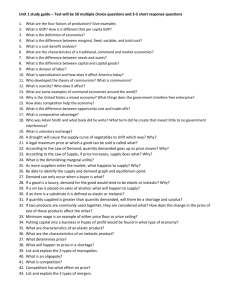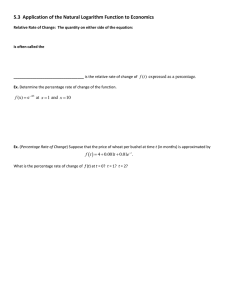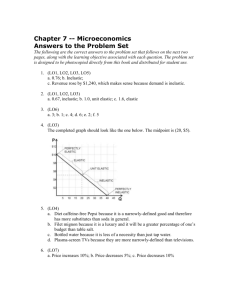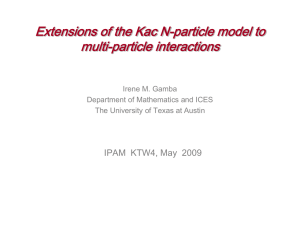Spectral-Lagrangian solvers for non-linear Boltzmann type equations: numerics and analysis
advertisement
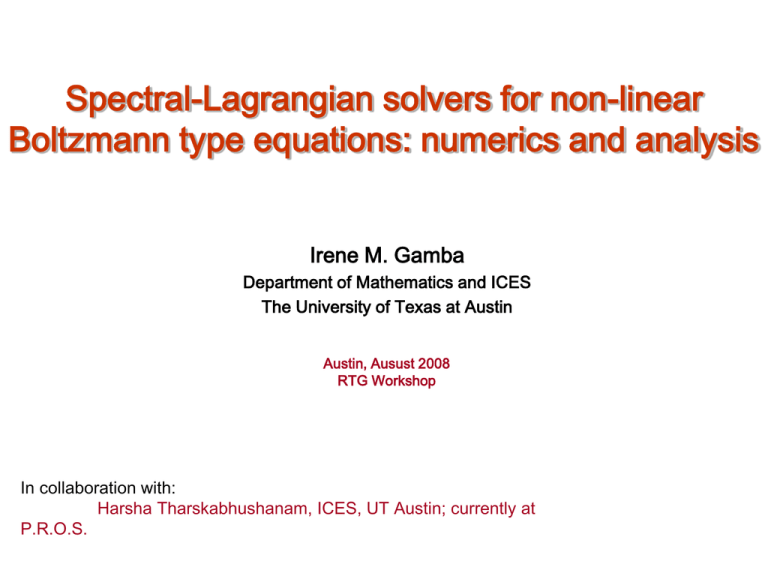
Spectral-Lagrangian solvers for non-linear Boltzmann type equations: numerics and analysis Irene M. Gamba Department of Mathematics and ICES The University of Texas at Austin Austin, Ausust 2008 RTG Workshop In collaboration with: Harsha Tharskabhushanam, ICES, UT Austin; currently at P.R.O.S. Motivations from statistical physics or interactive ‘particle’ systems 1. Initial Motivation: rarefied ideal gases: conservative Boltzmann Transport eq. 2. Energy dissipative phenomena: Gas of elastic or inelastic interacting systems in the presence of a thermostat with a fixed background temperature өb or Rapid granular flow dynamics: (inelastic hard sphere interactions): homogeneous cooling states, randomly heated states, shear flows, shockwaves past wedges, etc. 3. Soft condensed matter at nano scale: Bose-Einstein condensates models, charge transport in solids: current/voltage transport modeling semiconductor. 4. Emerging applications from stochastic dynamics for multi-linear Maxwell type interactions : Multiplicatively Interactive Stochastic Processes: Pareto tails for wealth distribution, nonconservative dynamics: opinion dynamic models, particle swarms in population dynamics, etc Goals: Search for common features that characterizes the statistical flow •A unified approach for Maxwell type interactions and •generalizations. • Analytical properties - long time asymptotics and characterization of asymptotics states: high energy tails and singularity formation ‘v v v* ‘v* C = number of particle in the box a = diameter of the spheres N=space dimension i.e. enough intersitial space May be extended to multi-linear interactions A general form statistical transport : The space-homogenous BTE with external heating sources Important examples from mathematical physics and social sciences: The term models external heating sources: •background thermostat (linear collisions), •thermal bath (diffusion) •shear flow (friction), •dynamically scaled long time limits (selfsimilar solutions). Inelastic Collision u’= (1-β) u + β |u| σ , with σ the direction of elastic post-collisional relative velocity Review of Properties of the collisional integral and the equation: conservation of moments Time irreversibility is expressed in this inequality stability In addition: The Boltzmann Theorem: there are only N+2 collision invariants →yields the compressible Euler eqs → Small perturbations of Mawellians yield CNS eqs. Hydrodynamic limits: evolution models of a ‘few’ statistical moments (mass, momentum and energy) Exact energy identity for a Maxwell type interaction models Then f(v,t) → δ0 as t → ∞ to a singular concentrated measure (unless exits a heat source) Current issues of interest regarding energy dissipation: Can one tell the shape or classify possible stationary states and their asymptotics, such as self-similarity? Non-Gaussian (or Maxwellian) statistics! Reviewing inelastic properties e e e e e Non-Equilibrium Stationary Statistical States Elastic case Inelastic case A new deterministic approach to compute numerical solution for non-linear Boltzmann equation: Spectral-Lagrangian constrained solvers (Filbet, Pareschi & Russo) (With H. Tharkabhushanam JCP’08) In preparation, 08 :observing ‘purely kinetic phenomena’ •This scheme is an alternative to the well known stochastically based DSMC (Discrete Simulation by Monte Carlo) for particle methods or alternatively called the Bird scheme. in σ Given find such that: A good test problem The homogeneous dissipative BTE in Fourier space (CMP’08) (CMP’08) (CMP’08) A benchmark case: Self-similar asymptotics for a for a slowdown process given by elastic BTE with a thermostat Soft condensed matter phenomena Remark: The numerical algorithm is based on the evolution of the continuous spectrum of the solution as in Greengard-Lin’00 spectral calculation of the free space heat kernel, i.e. self-similar of the heat equation in all space. reference time = mean free time Δt= 0.25 * reference time step. Testing: BTE with Thermostat explicit solution problem of colored particles Maxwell Molecules model Rescaling of spectral modes exponentially by the continuous spectrum with λ(1)=-2/3 mean free time = the average time between collisions mean free path = average speed X mft = average distance travelled between collisions mfp= 1 (mean free path ) Spatial mesh size Δx = r mfp Time step Δt = mean free time With N= Number of Fourier modes in each k-v-direction Elastic space inhomogeneous problem Shock tube simulations with a wall boundary Example 1: Shock propagation phenomena: Traveling shock with specular reflection boundary conditions at the left wall and a wall shock initial state. Time step: Δt = mean free time, mean free path l = 1, 700 time steps, CPU ≈ 55hs mesh points: phase velocity Nv = 16^3 in [-5,5)^3 - Space: Nx=50 mesh points in 30 mean free paths: Δx=3/5 Total number of operations : O(Nx Nv2 log(Nv)). Example 2 : Purely kinetic phenomena: Jump in wall kinetic temperature with diffusive boundary conditions. Constant moments initial state with a discontinuous pdf at the boundary, with wall kinetic temperature decreased by half its magnitude= `sudden cooling’ Resolution of discontinuity “near the wall” for diffusive boundary conditions: (K.Aoki, Y. Sone, K. Nijino, H. Sugimoto, 1991) Sudden heating: Constant moments initial state with a discontinuous pdf at the boundary wall, with wall kinetic temperature increased by twice its magnitude: Boundary Conditions for sudden heating: Calculations in the next four pages: Mean free path l0 = 1. Number of Fourier modes N = 243, Spatial mesh size Δx = 0.15 l0 . Time step Δt = mean free time Plots of v1- marginals at the wall and up to 1.5 mfp from the wall Comparisons with K.Aoki, Y. Sone, K. Nijino, H. Sugimoto, 1991 t/t0= 0.12 Jump in pdf Recent related work related to the problem: Cercignani'95(inelastic BTE derivation); Bobylev, JSP 97 (elastic,hard spheres in 3 d: propagation of L1-exponential estimates ); Bobylev, Carrillo and I.M.G., JSP'00 (inelastic Maxwell type interactions); Bobylev, Cercignani , and with Toscani, JSP '02 &'03 (inelastic Maxwell type interactions); Bobylev, I.M.G, V.Panferov, C.Villani, JSP'04, CMP’04 (inelastic + heat sources); Mischler and Mouhout, Rodriguez Ricart JSP '06 (inelastic + self-similar hard spheres); Bobylev and I.M.G. JSP'06 (Maxwell type interactions-inelastic/elastic + thermostat), Bobylev, Cercignani and I.M.G arXiv.org,06 (CMP’08); (generalized multi-linear Maxwell type interactions-inelastic/elastic: global energy dissipation) I.M.G, V.Panferov, C.Villani, arXiv.org’07, ARMA’08 (elastic n-dimensional variable hard potentials Grad cut-off:: propagation of L1 and L∞-exponential estimates) C. Mouhot, CMP’06 (elastic, VHP, bounded angular cross section: creation of L1-exponential ) Ricardo Alonso and I.M.G., JMPA’08 (Grad cut-off, propagation of regularity bounds-elastic d-dim VHP) I.M.Gamba and Harsha Tarskabhushanam JCP’08(spectral-lagrangian solvers-computation of singulatities) In the works and future plans Spectral – Lagrangian solvers for non-linear Boltzmann transport eqs. • Space inhomogeneous calculations: temperature gradient induced flows like a Cylindrical Taylor-Couette flow and the Benard convective problem. • Chemical gas mixture implementation. Correction to hydrodynamics closures •Challenge problems: •adaptive hybrid – methods: coupling of kinetic/fluid interfaces (use hydrodynamic limit equations for statistical equilibrium) • Implementation of parallel solvers. • inverse problems: determination of transition probabilities (collision kernels from BTE) Thank you very much for your attention! References ( www.ma.utexas.edu/users/gamba/research and references therein)

